Introduction
The China-bound Sony Xperia C could be the right opportunity to smuggle some big-screened, quad-core goodness into markets where those things usually fetch a high price. It's certainly the right size too. Five-inchers don't necessarily have to come with high-end price tags. There's demand for affordable options too, which the Xperia C isn't the first to address. Sony has obviously been watching the Samsung Galaxy Grand, while HTC and LG aren't indifferent either.
So, the Sony Xperia C has dual-SIM support, which is almost a must-have in the markets Sony's interested in, a massive 5-inch display and a quad-core processor. So far, so good.

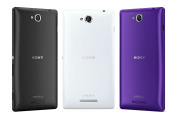

Sony Xperia C official pictures
It is the company's first smartphone powered by a MediaTek chipset. Sony has so far always opted for either Snapdragons or (when the company still existed) ST Ericsson but, with China being the primary target market, it had little choice really. The latest MediaTek chips support both dual-SIM and quad-core processors, and they are light on the wallet too.
Affordability is, of course, an important reason, considering Asian markets are teeming with sub-$200 quad-core droids and competition is fierce. The likes of Lenovo, Micromax, Xolo, and many more, are ready to offer a big enough screen and decent feature set on a bargain.
What this means is the Sony Xperia C should be preparing for a full-scale war. Let's check the ammo:
Key features
- Tri-band GSM/GPRS/EDGE and dual-band HSPA support
- Dual SIM, dual stand-by support
- 42.2 Mbps HSDPA and 11.5 Mbps HSUPA
- 5.0" 16M-color TFT capacitive touchscreen of qHD resolution (540 x 960 pixels) at 220ppi
- Android OS v4.2.2 Jelly Bean
- Quad-core 1.2 GHz Cortex-A7 CPU, PowerVR SGX544 GPU, MTK MT6589 chipset
- 1 GB of RAM
- 4 GB of built-in storage (2 GB user available)
- microSD slot (cards up to 32GB supported)
- 8 MP autofocus camera, single LED flashlight, geo-tagging, touch focus, HDR, hardware shutter key; VGA front-facing camera
- 1080p @ 30fps video capture
- Wi-Fi b/g/n, Wi-Fi hotspot
- Bluetooth 4.0 with A2DP
- GPS with A-GPS
- Accelerometer, ambient light and proximity sensor
- Standard 3.5 mm audio jack; Walkman music player with many audio enhancements
- Stereo FM radio with RDS
- microUSB port (charging)
- Built-in LED strip provides a breathing light and notification light
- 2,390mAh Li-Ion battery, non-replaceable
Main disadvantages
- Low pixel-per-inch ratio
- No Mobile BRAVIA engine
- No scratch protection for the screen, Gorilla Glass or otherwise
- Limited internal storage for installing apps
The Xperia C obviously didn't remain confined within Asian boundaries as various European retailers are already shipping it at very attractive prices. It sure isn't the fastest or the most feature-rich of phones, but it sounds like a great bang for your hard-earned buck. Will that be enough to probably forgive the lower resolution screen and the other potential deal breakers?

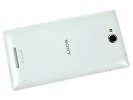
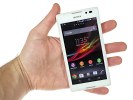
Sony Xperia C live pictures
We will find out soon enough. Jump over to the next page to see what's in the Xperia C's retail box and what the smartphone is really made of.
Unboxing the Sony Xperia C
The Sony Xperia C comes in an slim box, all the accessories placed in their separate and removable compartments. The contents are nothing out of the usual: an A/C adapter, microUSB cable, a white headset and some leaflets.
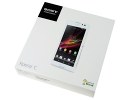
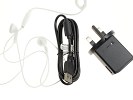
Sony Xperia C retail box
Design and handling
What we're looking at is yet another issue of the OmniBalance design that premiered on the Xperia Z early this year. It has been the signature styling of the entire Xperia lineup since, covering the entire price, size and performance range.


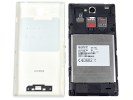
Sony Xperia C
Even though the rear cover is removable, the Xperia C still looks like a unibody phone and one that closely resembles the Xperia ZR. The few metallic elements along the sides make pleasant accents - a prominent element of the Xperia line's styling.
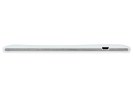

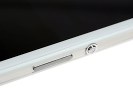
The sides of the Sony Xperia C
Keeping the design consistent across the entire range isn't a Sony invention but we like it how even their low-to-midrange devices don't look cheap. Perhaps a thing or two for Samsung to learn there.
The Xperia C's entire front is occupied by the massive 5" TFT screen with no hardware controls whatsoever, and bezels that could've been slimmer. Even with those, the Xperia C is still the same size as the top-of-the-line Xperia Z1.
The breathing LED is discretely hidden beneath the glass just below the screen. It illuminates a tiny slit that grows thinner at the edges and looks quite pleasant.
The Xperia C is a well-built phone. The removable rear panel doesn't bend or squeak, and the handset has an almost unibody look and feel.
The phone is big though and those bezels don't help either. The same size as the Xperia Z1, and a few grams lighter, it's slim enough to easily slip into pockets but its presence will always be felt. The phone is reasonably comfortable to handle.

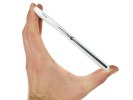
Handling the Xperia C
Display
The Sony Xperia C has a 5" LCD display of qHD resolution (540 x 960) for a decent, if hardly spectacular, 220ppi sharpness. The Samsung Galaxy Grand stretches its WVGA resolution far thinner and while there are some 720p options in the class, qHD is not a disadvantage here. There is no special anti-scratch surface over the screen and no special coating either, so the screen is very prone to fingerprints and not easy to clean.

Sony Xperia C's display
Color rendering looks okay, but the white balance is on the cold side meaning there is a subtle bluish tint. Typical for Sony smartphones, viewing angles are not impressive at all, with visible loss of contrast and color shift when you are not looking at the screen head on.


The screen matrix of the Xperia C next to the Xperia Z1
The overall image quality is certainly good for the class, although we noticed strange behavior with its brightness settings. We measured the display's brightness levels and as it turned out that actual 50% brightness is achieved when the slider is set at about 75% and when you set it in its half-way position the brightness is under a quarter of the maximum available. That's why the screen looks dim most of the time, unless you keep it close to the maximum.
As usually we did our battery test on 50% of the dedicated brightness slider and you should have that in mind when you are looking at its scores.
| Display test | 50% brightness | 100% brightness | ||||
| Black, cd/m2 | White, cd/m2 | Black, cd/m2 | White, cd/m2 | |||
| Sony Xperia C | 0.18 | 151 | 842 | 0.66 | 639 | 962 |
| Sony Xperia Z1 | - | - | - | 0.38 | 580 | 1513 |
| Oppo R819 | 0.56 | 607 | 1078 | 0.62 | 754 | 1210 |
| Samsung I9082 Galaxy Grand | 0.37 | 382 | 1040 | 0.62 | 586 | 948 |
| Huawei Ascend P6 | 0.14 | 136 | 986 | 0.62 | 670 | 1080 |
| Sony Xperia Z Ultra | - | - | - | 0.47 | 467 | 1001 |
| Huawei Ascend Mate | 0.23 | 222 | 982 | 0.67 | 711 | 1053 |
| Samsung Galaxy Mega 6.3 | 0.12 | 160 | 1364 | 0.32 | 440 | 1379 |
| Samsung I9505 Galaxy S4 | 0 | 201 | ∞ | 0 | 404 | ∞ |
| HTC One | 0.13 | 205 | 1580 | 0.42 | 647 | 1541 |
| Apple iPhone 5 | 0.13 | 200 | 1490 | 0.48 | 640 | 1320 |
The front display glass is quite reflective too, making the screen hard to read in direct sunlight.
Hardware and controls
Naturally, the earpiece is above the screen beneath a silver metallic grille. The VGA front camera is on the right, along with the proximity and ambient light sensors.
Below the earpiece grille is a tiny status LED that lights up orange when you are charging the phone (or you are running out of battery) and green once your battery is fully charged. There is also a notification light below the display, which blinks on missed events. Neither of those LEDs is user-configurable.
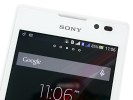
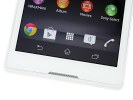
Earpiece, VGA camera and sensors above the screen • The notification light and the mic pinhole are below the screen
The microphone is below the screen beneath another metallic grille and there is no chance of accidentally muting it with a finger during calls.
The right side of the phone is where all the physical buttons are - starting with the aluminum Power/Lock key (a signature element of the OmniBalance design), the volume rocker (small, plastic but still easy to use) and the hardware shutter key (also made of plastic). Shutter keys are always welcome but this one in particular could've had better feedback - in either half or full press.


Physical shutter key, volume rocker and aluminum power button
The top of the Xperia C only features the 3.5mm audio jack, while only thing of interest on the left is the microUSB port.



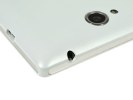
The USB port • 3.5mm audio jack
The lanyard eyelet is at the bottom of the phone - you'll need to open the back cover to attach the strap.
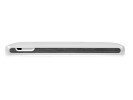

Lanyard eyelet on the bottom
On the back is the 8MP camera with LED flash and the metallic loudspeaker grille.

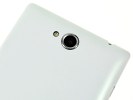
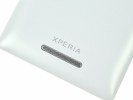
The back of the Xperia C holds the camera, its flash and the speaker
The battery cover fits tightly in place and can be quite hard to open - we had to almost twist the phone, so be careful the first couple of times you are trying to do this.
With the back cover off, you can access the two SIM beds and and the microSD card slot. Unlike other dual-SIM Xperia smartphones, the Xperia C offers 3G connectivity only on its primary SIM card. You can use both SIMs for internet connectivity, though you'll have to rely on EDGE speeds if you opt to use the card in the secondary SIM bed.


The battery compartment, microSIM and microSD card slots are all easily accessible
Battery Life
Sony put a 2390mAh battery inside the Xperia C. We ran the handset through our battery routine, making sure to have two SIM cards in. It scored 68 hours, which means you'll only need to charge the smartphone every 3 days if you use it for an hour each of talk-time, web browsing and playing video per day. Quite an impressive result indeed and possible because of the low-consumption Cortex-A7 processor cores and the fact that the screen brightness is actually at less than a quarter of its maximum level when the slider is set to 50%.

